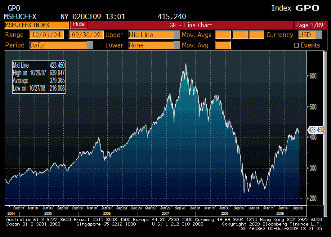
The Apollo Asia Fund's NAV rose 9% in the third quarter, to US$915.31 - up 25% year-on-year, but less than 2% above the previous peak of May 2008, after a rather large dip in between: charts.
In the third quarter, like the second, we made only modest changes to the portfolio. Four existing positions were boosted; two were trimmed; and one was reduced & rebuilt on wild price fluctuations.
| Geographical
breakdown by listing; 30 Sep 09 |
% of
assets |
| Hong Kong | 21 |
| Japan | 6 |
| Malaysia | 11 |
| Singapore | 31 |
| Thailand | 19 |
| Other equities | 10 |
| Net cash & receivables | 2 |
100 |
Were we top-down investors, we might have done much more. In Jan-Mar, opportunities abounded; now clearcut bargains are few. Three months ago, we were already refocussing on risk, and on judgments of relative resilience. As valuations have become more extended, these concerns remain to the fore. Part of the explanation for current inactivity lies in our 1Q decision to focus on companies with sustainable competitive strengths and growth potential, which we would wish to buy and hold for the long haul, rather than on the large number of deep value plays then available. While our excitement has dwindled as prices have risen, the shares we own are in good businesses, with valuations which remain justifiable, and which we are therefore reluctant to sell (unless our risk appraisal changes) until equally confident of alternatives.
At the end of September, the portfolio's historic EPS (based on the last full financial year to be reported) was down 10% from its peak last December (the last figure to reflect pre-crisis conditions), and we expect a further 10% decline in the current year, taking the current-year portfolio EPS estimate to 22% below its peak.
The historic PE of the portfolio is 13.3. Although it has been higher, reaching 15.2 in October 2007, this compares with 7.8 just six months ago - a rapid rebound from the bargain basement. Our current-year PE estimate, less reliable even than usual, is 14.8 - at the high end of the Fund's range since inception, although our company mix currently includes some with temporarily-depressed earnings and losses (we certainly hope their collapse of profitability is temporary, although the timing of full recovery remains uncertain), and some with high growth potential (accompanied by higher operational and price risks).
Portfolio BVPS has risen 33% yoy. Book value used to be a useful yardstick, but its value under IFRS is limited. On an aggregate basis, we would not place much confidence in this measure.
The current-year dividend yield is estimated at 3.1% after local taxes. The current-year estimate for portfolio DPS is 15% below its peak of March 2008. Since business conditions have rarely been tougher, this resilience seems reassuring.
 |
In July I wrote that the stock market advance, then four months old, appeared consistent with a rally in a bear market. Three months on, it still does. The rally extended, and recovered 50% of its losses: it would be no surprise if it now broke down. The economic problems of the developed world are enormous, and major faultlines have been papered over rather than durably tackled. Although the Fund's NAV is a touch above its May '08 peak, the outlook seems much bleaker (with problems compounded rather than worked through). Environmental crises are intensifying, and some resource constraints are becoming clearer and more pressing. It seems possible that we may see a prolonged global depression in which successive financial, economic, political, environmental and resource crises overlap and interact.
So far, such thoughts have served mainly to heighten awareness of some risks which are commonly overlooked, and which may be remote but could be game-changing. We have had less success in identifying new winners (which may be due to a deficiency of imagination, or because there would be far more losers). It seems plausible that more decisive action is warranted, but for the time being we continue to take baby-steps on the equity mix. Moreover we remain relatively fully invested, on the basis that we own resilient businesses which collectively generate respectable internal returns and cashflows from a reasonably broad range of economic activity, and that if such businesses in a difficult year are giving us an earnings yield of 6.8% when rates on bank deposits are derisory, it may be better to moderate our return expectations and compound those earnings rather than speculating on the recurrence of better buying opportunities.
The portfolio remains unhedged, as since inception: our track record suggests neither market-timing ability nor hedging skill. Investors may wish to apply their own overlay.
Thoughts from our well-informed investors are frequently helpful - thank you! - and are always welcome.
Claire Barnes, 5 October 2009
| Home | Investment philosophy | Fund performance | Reports & articles | *What's new?* |
| Why Apollo? | Who's Claire Barnes? | Fund structure | Poetry & doggerel | Contacts |